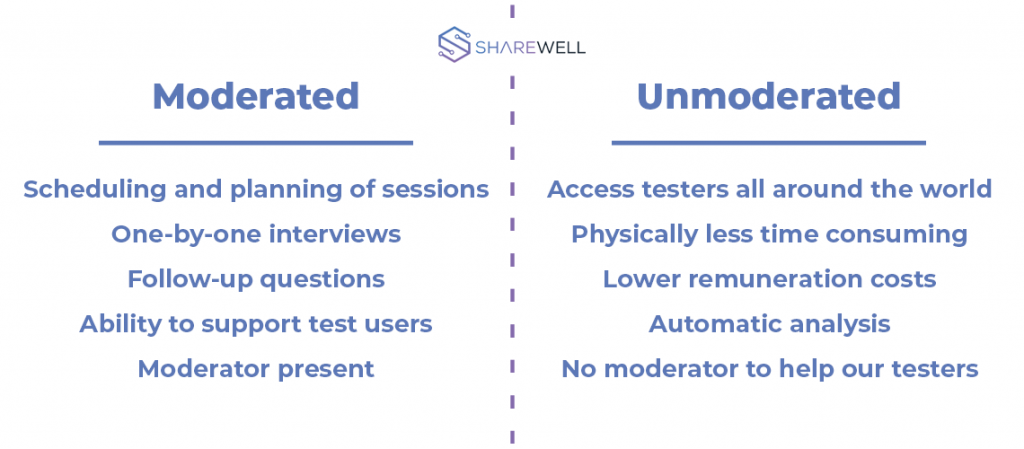Moderated vs. unmoderated user testing

Sharewell’s goal is to give companies a universal toolkit for user testing. Businesses have many options when creating a test, selecting their audience or setting rules for recruiting testers.
One of the benefits of this toolkit is the different options when creating tests. In addition to the traditional moderated user tests, Sharewell also provides test creators with the option to run unmoderated tests.
What are the differences between these two methods? Let’s compare moderated vs. unmoderated user testing.
Moderated user testing
This kind of user testing is more common. Tests are run in-person, participants are being recruited to engage in the test by coming to a physical location. There is also the need to schedule testers, record their sessions and have a moderator present to direct the flow of the session, ask additional questions and so on.
When it comes to moderated testing, managing test users is a big part of the process. In return, this has a lot of benefits.
For example, you have the luxury of asking follow-up questions. Also, you can help the participants throughout the process if they get stuck on some tasks or have some questions themselves. The moderator also has first-hand experience with how testers complete tasks.
Overall, moderated tests give the option to get further information on the spot and the moderator can react accordingly during the process.
On the other hand, this kind of testing is more expensive to run. Not only from the monetary side of things but also from the aspect of time. Scheduling members takes time, moderators can usually only have one-to-one interviews and tests take longer to set up. Unmoderated user testing solves these obstacles.
Learn how to create moderated test.
Unmoderated user testing
Without the need for a moderator, testers can take tests whenever they feel fit. There is no need for scheduling, as everything can be done online. With this in mind, creators can access testers all around the world. This is helpful when a company is planning to enter a new market or country but lacks the resources to conduct in-person tests abroad.
Furthermore, costs are lower, as there is no need to set up a physical location, acquire recording gear, and maybe even transport everything to another city. Testers need to invest less and resources for their participation, so remuneration costs are usually lower than the costs of moderated user tests.

There are some downsides to this. For example, the luxury of asking follow-up questions is out of the window. Nobody can react to the test session live and creators can’t really support the testers aside from the instructions given beforehand.
We have covered unmoderated user testing in a previous blog post, where we take a look at not only the obstacles but also benefits of this method. We explain how unmoderated user tests are easier to manage, give you the option to automatically analyse results and also reduce the chance of bias. You can find the post by clicking here.
Learn how to create unmoderated test.
Comparing these methods
Moderated tests require more time as participants are interviewed one-by-one. Scheduling them is also time-consuming. But you still have the chance of asking more questions on the spot, help out the participants if need be, and go in-depth with your testers to find out more than you first set out to.
Unmoderated tests are easier to manage. Test runners can acquire feedback from multiple users quickly and do everything easily online. Everything can also be recorded during the session and Sharewell can help analyse the data automatically. But the option of asking follow-up questions is not available.

How do companies apply these methods?
When comparing moderated vs unmoderated user testing, our experience shows that companies mainly employ unmoderated tests to gather information about user flow. This has also been very successful. With recorded sessions, test creators can easily see how testers act on their website, how they navigate around the pages and find information demanded.
Test runners can pinpoint problematic parts of their websites and make enhancements where needed.
Moderated tests are very useful when testing prototypes. Gathering information is key, as the product is only in the development stage and user input is very valuable. Testers can answer follow-up questions and give insight into how the product or service can serve them in the future. Also, which parts will be useful for them and which parts are confusing. Overall, a great way to gather ideas and insight on how to carry on.
Interpretation of test users’ feedback is clearly different and comes down to the choices made by test creators. Whether they need concrete answers to an already existing product or need to gather fresh ideas, test creators need to select the testing method that suits them best.
Automatic analysis is a great addition to unmoderated tests. Diving deep and finding out key ideas that can set new goals for your product is also beneficial, as it is with the moderated tests.
Choosing the testing method comes down to what needs to test. Also, how many resources are available and how much time is the test creator willing to invest.
Hopefully, this blog post gives a simple look at how moderated and unmoderated tests differ and when test creators should use them. Finding test users for both of these methods can be a tedious task as well.
Sharewell already maintains more than 20 000 test users on its platform. We are happy to help businesses find their real-world customers and gather valuable feedback about their products.


